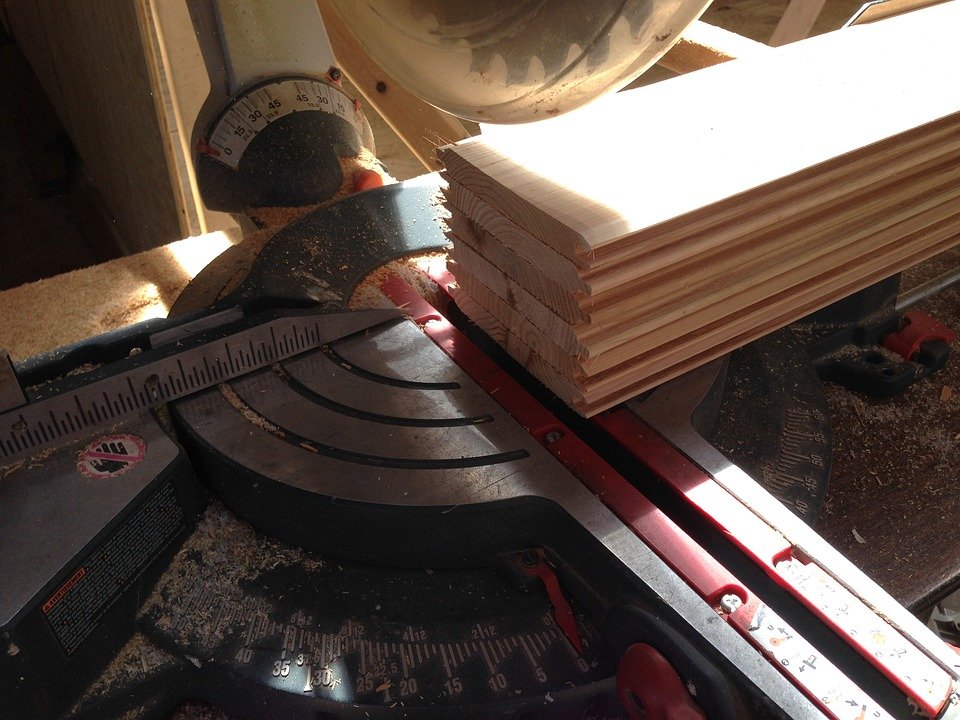When chop saws were first introduced during the 1970s, they were considered a breakthrough in the area of carpentry/woodworking tools because they promised to speed up the cutting work.
The chop saw is basically a lightweight circular saw used to make straight cuts of wood, metal or any other material. It is mounted on a spring-loaded pivoting arm and supported by a metal base. Aside from the speed it provides, a chop saw helps make more precise cuts of wood, metal or any other material.
While the chop saw doesn’t have the cutting abilities like the radial arm saw does, it is otherwise quite portable due to its relatively small size and light load. Despite these factors, the chop saw is durable enough to weather frequent use. Chop saws have become affordable as well.
The chop saw features a cutting wheel that typically measures 10 inches in diameter and has a motor generating power of 12 to 15 amps, which is powerful enough to make quick and clean 90-degree cuts in 2×4’s and 2×6’s. Rotating the blade left or right will cause the chop saw to make miter cuts. Some models can even be pivoted to make 45-degree cuts.
However, the chop saw’s cutting abilities are severely limited, confining only to making 5.5-inch cuts at 90 degrees, and even less when making miter cuts.
These very cutting limitations of the chop saw have prompted manufacturers to come up with models that have 12, 14, and 15-inch blades, which allows them to make cuts as wide as 7.5 inches, and as high as 3.5 inches.
Compound miter saw
Even with these newer configurations to improve the cutting abilities of the chop saw, some users are still not quite satisfied by it. Recently the sliding compound miter saws have emerged on the market. As a matter of fact, regular chop saws have been phasing out from the market.
A chop saw may have other features that can do angled or bevel cuts, which makes the chop saw as a miter saw too. Technically, this type is called the compound miter saw. It typically features blades that can be pivoted left and right to make angle cuts and can be also tilted in a single direction to make beveled cuts. Because of their ability to cut a variety of angles, compound miter saws are useful for jobs such as making quick cuts for picture frames, door trims, window casings, crown moldings, and so much more – while the workpiece lies flat on the table.
While compound miter saws are more versatile compared to chop saws, the former is also more expensive.
Most compound miter saws feature preset locked positions on the saw’s turntable, called detents. These detents are usually set at 0, 15, 22, 5, 30 and 45 degrees (which is square to the fence), as well as 15, 22.5, 30, and 45 degrees both to the left and right. You may also adjust the miter to your preferred position to make unique cuts without using the detent. If you need to make bevel cuts, the blade can be beveled to the right and locked up to 45 degrees. Some models can be beveled up to 45 degrees to both right and left, which is very useful for certain jobs such as making crown moldings.
Here are some important parts to consider to help you buy the ideal compound miter saw for your needs:
- Weight – Weight can be an important consideration especially if you move and work around a lot. For this reason, you may prefer a model which weighs as little as 30 pounds. Otherwise, you may opt for a heavier model which weighs at least 50 pounds.
- Handle – Most users prefer the D-shaped carrying handle which provides the tool more balance when it’s being picked up and carried around.
- Saw blade – Carbide-tipped saw blades are a standard in compound miter saws. Inexpensive models come with steel blades. If you want consistently good, smooth and straight cuts, you may want to replace the steel blade for a higher-quality blade.
- Blade guard – You may prefer to choose a model with an automatic blade guard that moves out by itself as the blade nears the cut. This will give you a better view of what you’re cutting.
- Accessories – Many units come with accessories such as the dust bag and table extensions. If you purchase a compound miter saw unit that doesn’t include such accessories, you may buy them separately when you need them.
